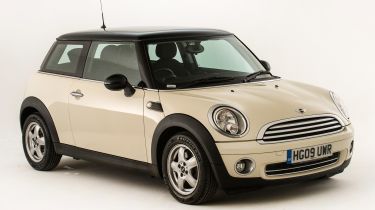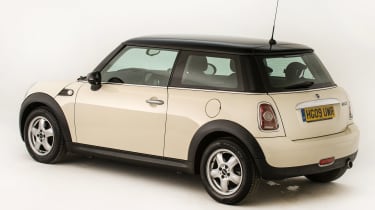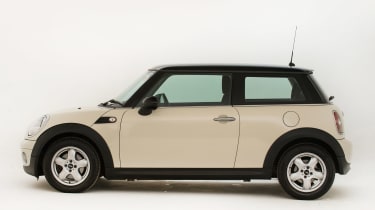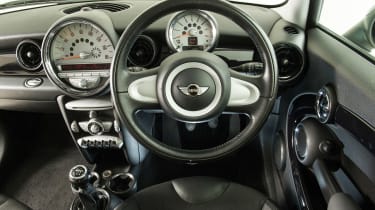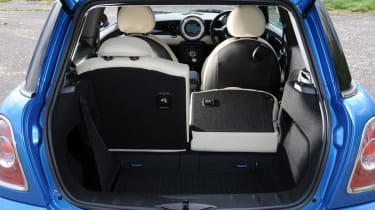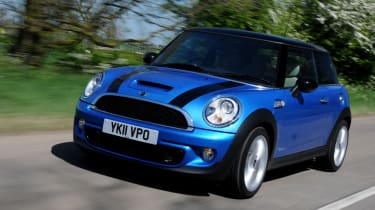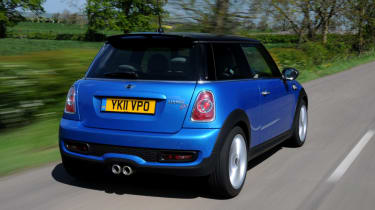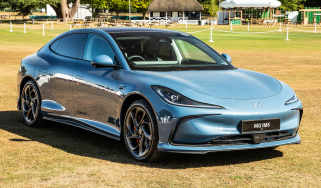Used MINI (Mk2, 2007-2014) review
MINI Hatchback is a relatively expensive used buy but remains as desirable as ever. Early examples are now very cheap
Verdict
The variety of MINIs on offer is bewildering; there are so many combinations of engine and trim level that it can be overwhelming. As a result, it can be hard to pin down what a MINI is worth, so don’t pay over the odds. Still, it’s a premium small car, so you’ll pay a bit extra for a MINI, but if you consider the generally excellent dealers, a good reliability record, plus a fun driving experience along with great styling inside and out, there are plenty of reasons to opt for this baby BMW.
Which one should I buy?
- Best Mini Hatchback for low costs: 1.4 First
- Best Mini Hatchback for fuel economy: 1.6 Cooper D
- Best Mini Hatchback for performance: 1.6 John Cooper Works
The second-generation MINI Hatchback went on sale in 2007. Priced between £12,995 and £15,995 for the Cooper and Cooper S respectively, both versions featured a 1.6-litre four-cylinder petrol engine, producing 120bhp in the Cooper and 175bhp in the Cooper S.
Rather than trim levels, MINI offered two packs: Pepper and Chili. Each one represented a 25 per cent saving over buying the options individually, so it’s rare to find a used MINI without one of the packs. An insurance-friendly MINI One, powered by a 1.4-litre petrol engine, arrived soon after the Cooper and Cooper S, and was followed by a new diesel version.
The tuned John Cooper Works edition hit the streets in 2008, with its 1.6-litre petrol engine producing an impressive 211bhp. At the other end of the spectrum, the entry-level MINI First arrived in 2009, with a 1.4-litre engine and a bargain price tag of £10,950.
Used - available now

2023 Vauxhall
Astra
11,209 milesAutomaticDiesel1.5L
Cash £21,199
2019 Ford
EcoSport
16,963 milesManualPetrol1.0L
Cash £10,495
2020 Vauxhall
Grandland X
45,973 milesManualPetrol1.2L
Cash £10,495
2023 Audi
e-tron
23,874 milesAutomaticElectric
Cash £19,983The MINI Hatchback was facelifted in 2010. By now, the range had grown to the One, One D, Cooper, Cooper D, Cooper S and John Cooper Works. All models were powered by 1.6-litre petrol and diesel engines, mated to a choice of six-speed manual or automatic gearboxes.
All MINI Hatchbacks of this generation feature three doors, so it’s just a question of working out which engine, gearbox and trim you want. But MINI is the king of personalisation, so you also need to pin down exactly what options are fitted to any potential purchase.
A raft of special editions makes it even harder to keep track of what you’re buying; these include the Soho, Graphite, Bayswater and Baker Street. All the engines are fine, although the 1.4-litre petrol unit isn’t ideal for motorway cruising; we’d also stick with the six-speed manual gearbox over the auto.
The First and One get steel wheels and the former does without air-con, so aim for at least a Cooper, which gets air-con and alloys. Few MINIs left a showroom without any options or one of the Salt, Pepper or Chili packs. It shouldn’t be too hard to find the MINI that’s right for you.
What are the alternatives?
An equally chic rival to the MINI is the Fiat 500, which is fun to drive, great-looking, good value and comes in hatch or cabrio forms. But it’s no roomier than the Brit.
The Audi A1 comes with a five-door option and is a class act. As you’d expect, it’s costly, too, although there are some great engines and build quality is excellent.
A less obvious rival is the Alfa Romeo MiTo, which looks smart and is offered with some strong engines. The interior is classic Alfa, however, so it looks inviting even if the ergonomics are a bit suspect in places; it’s decent value as well. Don’t overlook the Citroen DS3, either. It’s spacious and fun to drive, plus it’s an attractive choice.
Mini vs Fiat 500
Back in 2013, it was a case of handbags at dawn for two of the country’s most fashionable small cars. Two cars dripping in retro appeal, chic charm and a plethora of personalisation options. Which cute car emerged victorious? Read the full test…
How much will a used MINI Hatchback cost?
The launch of the current MINI Hatchback in 2014 should mean that the MINI Mk2 prices are generally affordable. This is helped by the fact that the Mk2 arrived back in 2007, so the earliest cars are approaching pensionable age. That said, demand is high, so act fast if you’re after the best examples with the more desirable kit.
Prices
Even the latest models of the MINI Mk2 are too old to appear on our sister site BuyaCar, so you’ll need to scour the online classifieds to find the right car for you. Buying from a dealer should give you some peace of mind, but you’ll save money if you buy privately.
Prices start from around £1,000 if you’re prepared to put up with a few battle scars, sketchy service history or an insurance write-off to its name. Better to increase the budget to £2,000 for the pick of the earliest cars. You’ll pay up to £15,000 for a late John Cooper Works or a Cooper S with all the bells and whistles.
You can check out the latest used prices for the Mini Hatchback on our Find a Car service or value a specific model using our free car valuation tool.
Fuel economy and emissions
The low running costs, especially with the diesel models fitted with BMW's 1.6-litre engine, should more than make up for paying more for a used MINI. At launch, MINI claimed that the Cooper could return a combined 48.7mpg, with the Cooper S dropping to 40.9mpg. It’s worth noting that these are pre-WLTP figures, so you’re likely to see poorer fuel economy in the real world.
The figures for the post-facelift (2010) cars provide a good overview of the different figures, although they remain pre-WLTP and are not entirely accurate. MINI claims the One D and Cooper D are capable of 74.3mpg and 99g/km of CO2 with a manual gearbox, while the One and Cooper variants offer a respectable 52.3mpg and 127g/km. These figures are based on cars riding on 15-inch steel or alloy wheels. The Cooper S sits on 16-inch alloys and could return figures of 48.7mpg and 136g/km.
Predictably, opting for the John Cooper Works edition results in a drop in fuel economy, although figures of 39.8mpg and 165g/km CO2 are far from disappointing for a performance hot hatch.
The 1.4-litre engine in some versions of the First and One isn’t quite the economy hero it’s cracked up to be. Figures of 53.3mpg and 128g/km CO2 are okay, but the engine has to be worked hard to get the best from it, especially in the detuned First model, which puts a dent in overall fuel economy.
Running costs
All MINI Mk2s have variable servicing, allowing up to two years between checks. Cars built up to 2009 would generally go for 10,000 to 15,000 miles between services; from this point on, a more sophisticated system was introduced, allowing up to 20,000-mile intervals.
Fresh brake fluid is required every two years (at £50), while the air-con is checked every service; recharging it costs around £80. There’s no cambelt to replace.
Most MINIs came with the all-inclusive TLC servicing package, which lasted five years or 50,000 miles; this could have been topped up by another three years or 30,000 miles for £275. Many dealerships offer discounts to keep costs low.
What do owners think?
Build quality is good, but there are some question marks over reliability, with reports of issues with some electrical components. But few major faults have been reported and the dealer network seems to be effective at dealing with issues as and when they crop up.
Back in 2013, MINI finished a poor 28th out of 32 in the 2013 Driver Power customer satisfaction survey manufacturer rankings, while the hatchback even failed to break into the top 100 of the league table, finishing 141st out of 150 cars. In fairness, many of the negative comments focused on the car’s poor practicality rather than reliability issues.
Reliability
MINI finished a middling 19th on the list of manufacturers in our 2021 Driver Power customer satisfaction survey. Room for improvement, although MINI did finish ahead of parent company BMW, as well as Audi and Land Rover.
How practical is it?
Despite being significantly larger than the original Mini, practicality is not a strong point. The rear bench is cramped for adults and the boot is extremely small. Even with the rear seats folded it can't match the Audi A1 or Citroen DS3 for loading space. However, if practicality is a priority, it's worth looking at other models in the MINI range - like the Clubman and Countryman.
Dimensions, cabin and boot space
At 3,723mm long (3,729mm for the Cooper S), 1,913mm wide and 1,407mm tall, the MINI Hatchback Mk2 is larger than its predecessor, but it’s far from the most practical small car you can buy. In fact, this is one of the MINI’s weakest areas. Planning a MINI adventure? You’d better pack lightly and think about leaving your friends at home.
It’s a car designed for two people, with the cabin offering a fair amount of storage space, including a pair of cup holders in the front and two in the back. Unfortunately, the door pockets are shallow and awkward to use, but the real frustrations can be found further back.
Getting into the back seats can be a painful experience, and things aren’t much better once you’re there. Headroom is adequate for a car of this size, but the legroom is barely enough for children, let alone adults. It’s also a strict four-seater, so families with 2.4 children should look elsewhere.
The luggage capacity is similarly miserly, with just 160 litres of space available in the boot. That’s less than you’ll find in a Ford Ka city car. Fine for a few shopping bags or a single suitcase, but anything beyond that will require the 50/50 rear seats to be folded down. This increases the capacity to 680 litres. On the plus side, all cars get a pair of Isofix mounting points in the back.
These criticisms should be viewed in the context of the MINI experience. Owners love their cars and are prepared to sacrifice practicality for the style, image and driving fun. For greater practicality, consider the current MINI, which is available as a five-door model, along with rivals like the Ford Fiesta, Renault Clio and Peugeot 208.
Equipment and technology
At launch, the Cooper came with 15-inch alloy wheels, tinted glass, roof spoiler, electric front windows, engine start/stop button, height-adjustable driver’s seat, radio, CD player, cloth seats, rev-counter with outside temperature display and an aux-in connection. Hardly the last word in connectivity and entertainment, but things were different in 2007, even in a MINI.
The Cooper S adds 16-inch alloy wheels, sport button, automatic stability control, honeycomb radiator grille, chequered cloth sports seats, Cooper S roof spoiler, leather steering wheel and gear knob, run-flat tyres, twin exhaust pipes and white indicators.
There were many options to choose from, so it’s worth familiarising yourself with the available kit. Metallic paint, leather seats, sports suspension, multifunction steering wheel, 17-inch alloy wheels, bonnet stripes, heated seats, air-con, navigation, TV, Bluetooth, bi-xenon headlights, panoramic sunroof, DAB radio and parking sensors were just some of the options.
Look out for the option packs. The £940 Pepper pack was available on the MINI Cooper and included leather steering wheel, chrome line exterior, velour floor mats, passenger seat height adjustment, front fog lights, manual air-con, on-board computer and interior lights pack.
At £1,875, the Chili pack cost even more and featured everything included in the Pepper pack plus different kit, depending on the model. The Cooper gets 16-inch alloys, rear roof spoiler, chrome exterior line and sports seats, while the Cooper S is available with optional sports suspension, 17-inch alloy wheels and bi-xenon headlights.
The First and One models were designed with price and economy in mind, so you shouldn’t expect to find too many desirable features. Both cars ride on 15-inch steel wheels, while the First didn’t even come with air-con as standard. As ever, few of these entry-level cars left the showroom without any options, so look out for used cars with the Salt, Pepper, Design and Tech packs.
Buying a MINI after the 2010 facelift will ensure you get more for your money, along with improved controls for the revised audio system, a new range of interior and exterior colours, plus an MP3 and aux-in connection for all models.
The John Cooper Works (JCW) edition features 17-inch alloy wheels, air-conditioning, DAB radio, three-spoke Alcantara steering wheel, rear parking sensors, sport button, sports seats and a suite of JCW styling enhancement. Not everything came as standard, so find a JCW with the optional Chili pack for automatic air-con, Bluetooth, USB connection, bi-xenon headlights, cloth/leather seats, interior lights pack, multifunction steering wheel, on-board computer, passenger seat height adjustment and storage compartment pack. Sport suspension was a no-cost option when ordered in conjunction with the Chili pack.
Safety
The MINI Cooper achieved a maximum five-star rating for adult occupant protection when it was crash-tested by Euro NCAP in 2007. It was awarded a three-star rating for child occupant safety and two stars for pedestrian safety. Good figures for the time, but the absence of modern driver assistance systems would mean that the MINI wouldn’t achieve these ratings if tested using the current criteria.
The MINI Mk2 is certainly safer than the first-generation model. All cars feature ABS, corner braking control, crash sensors, disc brakes all-round, electronic braking distribution (EBD), rear Isofix points, passenger airbag deactivation, tyre-pressure warning and multiple airbags (including new curtain head airbags). Electronic stability control was optional on the First and One models.
What’s it like to drive?
MINI likes to call it ‘kart-like handling’, and while you might roll your eyes at the cliché, there’s no denying that few small cars are as good to drive as a MINI. It doesn’t matter if you’re at the wheel of an entry-level First or One, or the bonkers John Cooper Works, you will have fun in a MINI.
Engines and performance
Although there’s a bewildering array of options and accessories to choose from, the choice of engines is relatively simple.
The 1.4-litre petrol, found in early versions of the MINI One and MINI First, is the weakest of the engines, but it’s fine in town. It’s also likely to be the cheapest to insure, although because it needs to be pushed hard to get the best from it, you’re unlikely to approach MINI’s claimed fuel economy. The unit, which produces 95bhp in the One and 75bhp in the First, is sluggish and unrefined by modern standards.
The 120bhp 1.6-litre petrol engine in the Cooper is a better all-rounder, offering a 0-62mph time of 9.1 seconds and a top speed of 126mph. Like the 1.4-litre unit, it needs to be worked hard to get the best from it, which leaves the 1.6-litre turbocharged petrol engine in the Cooper S to extract the best from the MINI’s fine chassis. It’ll hit 62mph in 7.1 seconds before going on to reach a top speed of 140mph.
For a terrific blend of performance and economy, look no further than the 1.6-litre diesel in the One D and Cooper D. It produces 89bhp in the One, for a 0-62mph time of 11.4 seconds and a top speed of 114mph. For greater punch, take a look at the 120bhp Cooper D, which boasts a top speed of 122mph and a 0-62mph time of 9.7 seconds. It’s great for overtaking and long motorway cruises. The Cooper SD uses BMW’s 141bhp 2.0-litre diesel engine.
Finally, the John Cooper Works has the same 1.6-litre turbocharged engine as the Cooper S but with the wick turned up to 211bhp. A 0-62mph time of 6.2 seconds and top speed of 148mph enable the JCW to rub shoulders with some of the best hot hatchbacks.
On the road
One of the MINI's strengths is the way it drives. No matter which engine you go for, the handling is sharp and will put a smile on your face. The stiff suspension won't be to everyone's tastes, but the pay-off is huge fun behind the wheel.
We start, appropriately enough, with the First, which delivers the same near-faultless driving experience as other models in the range. Wonderfully accurate steering, superb body control and delightfully agile handling ensure this city car always raises a smile on the open road.
The relatively small wheels and skinny tyres mean the limit of grip arrives sooner than in sportier MINIs, but there’s a purity to the feedback from the superb chassis. And although the ride is still firm, the First’s suspension isn’t as unforgiving over bumpy surfaces as other models. Wind noise is well suppressed at motorway speeds, and the brakes have a positive, firm action.
At the opposite end of the MINI Hatchback spectrum, the straight-line performance of the John Cooper Works is astonishing. It also handles like a race car – with the help of a lot of technology.
Its armoury includes switchable traction control, which can be left on for maximum stability or turned off partially for more wheelspin. This, combined with quick, accurate and decisive steering means the JCW is one of the purest driver’s cars of all the modern MINIs. Surprisingly, the JCW is reasonably comfortable – unlike some rivals, the hatch won’t loosen your fillings over rough surfaces.
The Cooper and Cooper S (including the diesels) strike the best balance between the cheap frills of the First/One and the rabid performance of the JCW. Precise steering, sharp handling and yes, a ‘kart-like’ feel behind the wheel, make the MINI a fantastic driver’s car. Just avoid the larger alloy wheels if you want to retain the otherwise excellent ride comfort.
What should you look out for?
Build quality is generally good and there are few common faults to report. Problems tend to arise as the cars get older and motorists running a car on a budget miss recommended service intervals or fail to attend to basic maintenance.
Common used MINI Hatchback problems
Electrics
Electrical problems arise when the battery earthing strap fails. The electrics can be lost altogether, so make sure everything works.
Sound system
If you’re looking at a MINI with an upgraded sound system, check that the speakers work properly; they don’t always.
Flywheel
Diesel MINIs can suffer from failure of the dual-mass flywheel, and a replacement is expensive. Listen out for rattling.
Starter motor
Some cars have been suffering from weak starter motors, so make sure the one that’s fitted will spin the engine over happily.
Recalls
The MINI Hatchback Mk2 has been recalled just once, with cars built from July to October 2007 affected. The rear anti-roll bar was too large in diameter; this meant it could detach, leading to a loss of steering control.
Brake discs of too small a diameter were fitted to certain John Cooper Works models made in 2008, forcing another recall, and some Cooper S and John Cooper Works cars were also called back. This was because the circuit board for the turbo’s water pump could short circuit.

